Blue Sage
(Salvia pachyphylla)
Blue Sage (Salvia pachyphylla)
/
/

Dick Culbert from Gibsons, B.C., Canada
CC BY 2.0
Image By:
Dick Culbert from Gibsons, B.C., Canada
Recorded By:
Copyright:
CC BY 2.0
Copyright Notice:
Photo by: Dick Culbert from Gibsons, B.C., Canada | License Type: CC BY 2.0 | License URL: https://creativecommons.org/licenses/by/2.0 | Uploader: McZusatz | Publisher: Wikimedia Commons | Title: Salvia_pachyphylla,_the_Rose_Sage_(10461533306).jpg | Notes: Transferred from Flickr via [[Commons:Flickr2Commons|Flickr2Commons]] |
























Estimated Native Range
Summary
Salvia pachyphylla, commonly known as Blue Sage, is an evergreen subshrub native to the chaparral and high desert ecosystems of the Southwestern USA and Baja California. It typically grows to a height of 2-3 feet (0.6-0.9 meters) and spreads 2-3 feet (0.6-0.9 meters) wide. Blue Sage has a compact form with silvery-green foliage and a profusion of blue to purple flowers that bloom from mid-summer to early fall, providing a showy display that attracts pollinators such as bees and hummingbirds.
Blue Sage is valued for its drought tolerance, aromatic leaves, and striking flower color, making it a favorite for xeriscaping, rock gardens, and native plant landscapes. It thrives in full sun and requires well-draining soil, making it suitable for areas with low water availability. While it is generally low-maintenance, it is important to avoid overwatering to prevent root rot. Blue Sage can also be used in herbal medicine, and its leaves are sometimes used to flavor foods.CC BY-SA 4.0
Blue Sage is valued for its drought tolerance, aromatic leaves, and striking flower color, making it a favorite for xeriscaping, rock gardens, and native plant landscapes. It thrives in full sun and requires well-draining soil, making it suitable for areas with low water availability. While it is generally low-maintenance, it is important to avoid overwatering to prevent root rot. Blue Sage can also be used in herbal medicine, and its leaves are sometimes used to flavor foods.CC BY-SA 4.0
Plant Description
- Plant Type: Subshrub, Shrub
- Height: 1-3 feet
- Width: 1.5-2.5 feet
- Growth Rate: Moderate
- Flower Color: Blue, Purple
- Flowering Season: Fall, Spring, Summer
- Leaf Retention: Evergreen
Growth Requirements
- Sun: Full Sun
- Water: Medium
- Drainage: Fast
Common Uses
Bank Stabilization, Bee Garden, Bird Garden, Border Plant, Butterfly Garden, Deer Resistant, Drought Tolerant, Erosion Control, Fragrant, Hummingbird Garden, Low Maintenance, Rabbit Resistant, Showy Flowers
Natural Habitat
native to the chaparral and high desert ecosystems of the Southwestern USA and Baja California
Other Names
Common Names: Mountain Desert Sage, Rose Sage
Scientific Names: , Salvia pachyphylla, Audibertia incana var. pachystachya, Salvia compacta, Audibertia pachystachya, Ramona pachystachya, Salvia carnosa var. compacta,
GBIF Accepted Name: Salvia pachyphylla Epling ex Munz